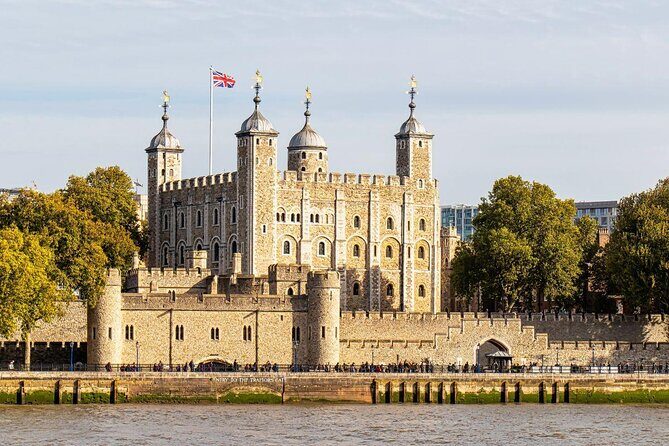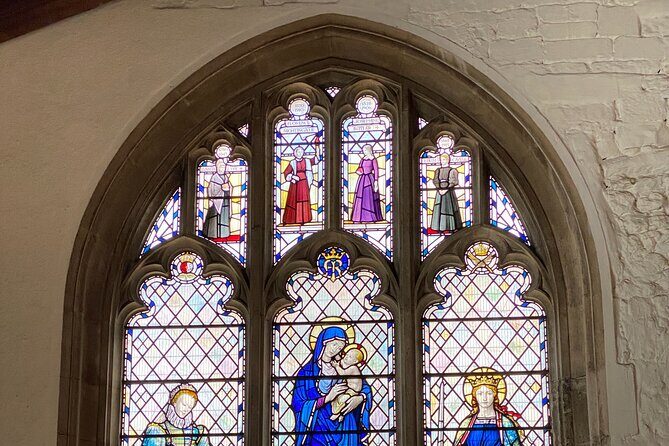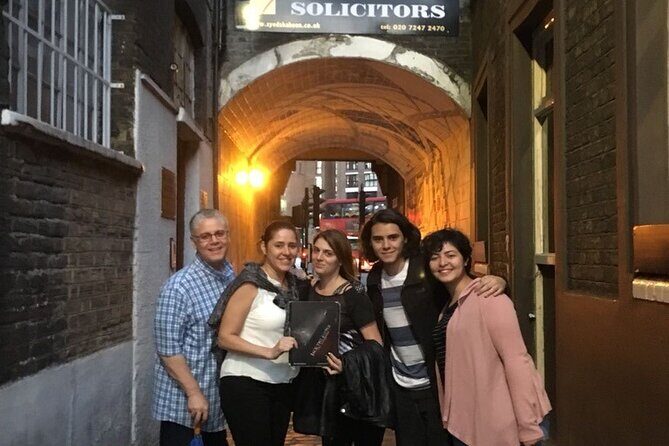Exploring London’s Hidden Past: The Slavery and City of London Walking Tour
If you’re visiting London and looking to go beyond the typical sightseeing list, the Slavery and City of London Walking Tour offers a compelling look into the city’s less-visible history. For just over twenty-seven dollars, this 1.5-hour guided walk takes you through the heart of the City, revealing how the profits of slave labor helped shape some of London’s most iconic sites. Led by knowledgeable guides—like Sam, who has garnered rave reviews—you’ll visit landmarks from the Roman walls to the Bank of England, all while learning about the darker chapters of British history.
What makes this tour especially rewarding is its focus on hidden stories that most travelers miss. We love how it connects the dots between historic institutions and the transatlantic slave trade, giving context to the landmarks we often take for granted. The tour’s small group size—max 35—ensures you get a personal experience and plenty of opportunity to ask questions.
One thing to consider is the duration; with only an hour and a half, some might feel that the topic deserves more time, but the tour’s brisk pace keeps it lively and engaging. Perfectly suited for history buffs, socially conscious travelers, or anyone curious about the lesser-known sides of London’s development, this walk offers both insight and reflection, making it a meaningful addition to any London itinerary.
Key Points

- In-depth exploration of London’s connection to the slave trade and how it influenced city landmarks.
- Expert guides like Sam deliver engaging, well-informed commentary.
- Short but impactful 1 hour 30-minute walk, perfect for busy schedules.
- Visits to significant sites such as the Roman wall, Bank of England, and St. Paul’s Cathedral.
- Focus on hidden stories within familiar landmarks, revealing London’s complex history.
- Great value for the cost, with many reviewers calling it a must-do experience.
A Closer Look at the Itinerary

This tour packs a lot into a short walk, starting at the Tower Hill Tram and Trinity Square. From there, you’ll venture into the depths of London’s history—both the ancient and the more recent—offering a layered perspective on the city.
If you're drawn to exploring London on foot, we've looked into these other walking experiences
The Roman Wall of Londonium
We begin at the Roman wall, a remnant of Londinium from nearly 2,000 years ago. While it’s a modest site, it’s fascinating to think of the Romans taking Britons as slaves—a reminder that London’s history of forced labor predates the modern era. The guide explains how this ancient boundary is still visible beneath modern buildings, making it a tangible link to the past.
East India House and the East India Company
Next, we pass the site of East India House, the former headquarters of the powerful East India Company. As we learn, this organization relied heavily on slave labor and trafficked in slaves from Africa—highlighting Britain’s early involvement in the transatlantic trade. The location underscores how deeply intertwined commerce and slavery were in Britain’s rise.
Fen Gardens and the Gilt of Cain Sculpture
A stop at Fenchurch Street introduces the Gilt of Cain Sculpture, a striking piece commemorating the abolition of the transatlantic slave trade. This serves as a sobering reminder of the long fight for freedom and justice, making it a perfect spot for reflection.
The Jamaica Wine House and the Roots of Coffee Culture
The tour then visits the Jamaica Wine House, historically London’s first coffee house. Interestingly, this spot was a hub linked to the sugar trade and West Indies slave plantations, reminding us how even social venues are connected to this darker history.
For broader city exploration in London, we've covered these other tours
St. Mary Woolnoth and John Newton
We pop into St. Mary Woolnoth, where John Newton, the former slave trader turned abolitionist, was rector. Newton’s story is a powerful testament to personal transformation and the ongoing struggle for human rights.
The Bank of England Museum
One of the tour’s highlights is the visit to the Bank of England Museum. The Bank has publicly apologized for the involvement of past directors in the slave trade, and has committed to removing statues and paintings of those figures. This ongoing effort reflects how institutions grapple with their historical links to slavery.
Royal Africa Company Headquarters
We also see the building that symbolized London’s role in the transatlantic slave trade, where city officials and shareholders of the Royal Africa Company met, showing how economic power was built on enslaved labor.
Final Stop: St. Paul’s Cathedral
The walk concludes near St. Paul’s Underground Station. While most visitors admire St. Paul’s for its grandeur, this tour offers a different view—one that ties the majestic cathedral to the broader, often uncomfortable history of London’s development.
Authentic Experiences and Insights
Throughout the walk, the guide’s enthusiasm and knowledge shine. As one reviewer notes, “Sam spoke with clarity; he was engaging and very knowledgeable giving us insight into Roman and Victorian London.” The group size keeps things intimate enough for questions, and the pace allows for reflection.
Many reviewers rave about how eye-opening the tour is. Described as “refreshing and different,” it offers a perspective that’s rarely included in standard city tours. The stories about how London’s wealth was built on slavery resonate deeply, especially when visiting landmarks like the Bank of England or the Royal Africa Company building.
The value for money is evident. For about $27, you get a well-rounded, meaningful experience that’s both educational and thought-provoking. The tour’s short duration makes it perfect for those with limited time but a keen interest in understanding London’s complex history.
Practical Details: What to Expect

The tour begins promptly at 12:00 pm at Tower Hill Tram, Trinity Square. It lasts approximately 90 minutes, covering about six significant stops. The route finishes at Aldgate Station, conveniently located on the Central Line, making it easy to continue exploring or heading back to your accommodation.
The group is capped at 35 travelers, ensuring a more personal experience. The tour is mobile ticket-based, and confirmation is instant upon booking. Most travelers find it suitable, but if you’re especially sensitive to historical topics, you might want to prepare for some sobering content.
The tour is weather-dependent, but if canceled due to rain or other poor conditions, you will be offered a replacement date or a full refund.
Who Will Benefit Most?
This tour is ideal for history enthusiasts, social justice advocates, or curious travelers eager to learn about London’s wider story. It’s particularly suited for people who want to understand the economic and social roots of many city landmarks, not just admire their architecture. The stories of reconciliation and accountability—like the Bank’s promises—add relevance for modern audiences.
If you’re traveling with a group that appreciates in-depth stories and meaningful reflection, this experience will resonate. But keep in mind, it might not appeal if you’re looking for light-hearted sightseeing or a lengthy cultural deep dive.
FAQ

Is this tour suitable for children?
While most travelers find it accessible, it’s best suited for older children or teenagers with an interest in history and social issues, as the topics covered can be quite serious.
How long is the tour?
It lasts about 1 hour and 30 minutes, covering six key sites in the City of London.
What is the group size?
The maximum number of participants is 35, which helps keep the experience intimate and engaging.
Where does the tour start and end?
It begins at Tower Hill Tram, Trinity Square, and finishes at Aldgate Station.
Is the tour accessible for people with mobility issues?
Most of the stops are on paved surfaces, but it’s best to check with the provider for specific accessibility questions.
How much walking is involved?
Expect moderate walking, with stops at each location for discussion and photos.
What should I wear?
Comfortable walking shoes and weather-appropriate clothing are advised, especially if rain is forecast.
Are tickets refundable?
Yes, there is a full refund if you cancel at least 24 hours in advance. Cancellations less than 24 hours before the start are non-refundable.
Is there an age limit?
Most travelers can participate, but younger children might find the historical content less engaging.
In essence, the Slavery and City of London Walking Tour offers a rare and compelling look into London’s complex history—one that’s often hidden behind its grand facades. With expert guides, meaningful stories, and accessible locations, this walk adds depth and understanding to your visit, making it a truly worthwhile investment for those eager to explore the full story of Britain’s capital.
More Walking Tours in London
- WW2 London Walking Tour & Churchill War Rooms Entrance Ticket
- Buckingham Palace Visit & Changing of the Guard Walking Tour
- Southbank Immersive Self-Guided Audio Walking Tour
- Royal English Walking Food Tour With London Food Tours
- Private Custom Walking Tour: Half Day Sightseeing Tour of London
- Shoreditch Self-Guided Walking Tour: Art, Cuisine & Culture
More Tours in London
- Private Guided Tour of Royal London
- Private Chauffeured Tour to Hever Castle from London
- WW2 London Walking Tour & Churchill War Rooms Entrance Ticket
- Buckingham Palace Visit & Changing of the Guard Walking Tour
- London Exclusive Christmas Lights Guided Tour by Black Cab
- Southbank Immersive Self-Guided Audio Walking Tour
More Tour Reviews in London
- Private Prison Van Escape Game – London Immersive Experience
- Private Guided Tour of Royal London
- London Private Chauffeur Half-Day or Full-Day Vehicle Rental
- Private Chauffeured Tour to Hever Castle from London
- WW2 London Walking Tour & Churchill War Rooms Entrance Ticket
- Buckingham Palace Visit & Changing of the Guard Walking Tour
More London experiences we've covered
- Private Prison Van Escape Game – London Immersive Experience
- Private Guided Tour of Royal London
- London Private Chauffeur Half-Day or Full-Day Vehicle Rental
- Private Chauffeured Tour to Hever Castle from London
- WW2 London Walking Tour & Churchill War Rooms Entrance Ticket
- Buckingham Palace Visit & Changing of the Guard Walking Tour
- The City of Dreaming Spires: Oxford Private Day Trip from London
- London Exclusive Christmas Lights Guided Tour by Black Cab
- Urban Canvas: Exploring Shoreditch’s Vibrant Street Art
- Southbank Immersive Self-Guided Audio Walking Tour
- The Best Harry Potter Tour & The London Dungeons
- Windsor Castle, Stonehenge & Roman Baths Private Tour
